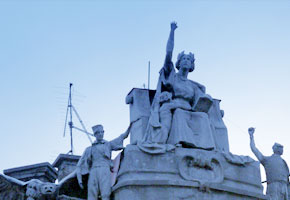The Long, Troubled Road to Today’s Bosnia
January 4, 2008
 Following Austria-Hungary’s control of Bosnia and Herzegovina after the Treaty of Berlin in 1878, there were a string of political and social reforms mandated, which were intended to make Bosnia and Herzegovina an exceptional colony. While reforms in politics and generally modernization were quite successful, Austro-Hungarian rule brought about rising nationalism amongst the South Slavs.
Following Austria-Hungary’s control of Bosnia and Herzegovina after the Treaty of Berlin in 1878, there were a string of political and social reforms mandated, which were intended to make Bosnia and Herzegovina an exceptional colony. While reforms in politics and generally modernization were quite successful, Austro-Hungarian rule brought about rising nationalism amongst the South Slavs.
Onset of WWI
In 1908, the area of Bosnia-Herzegovina was formally annexed, and the nationalist movement became even more fervent and urgent. On June 28, 1914, the heir to the Austro-Hungarian throne, Archduke Franz Ferdinand, was assassinated by a Serbian nationalist named Gavrilo Princip in Sarajevo.
WWI
The assassination of Archduke Franz Ferdinand is considered to have been the trigger of World War I. After Princip assassinated the Archduke, Austria declared war on Serbia. What followed was an ever-increasingly complicated alliance system that eventually ignited conflict. Russia supported Serbia after Austria declared war, and Germany followed suite by supporting Austria against Serbia . France supported Serbia, prompting Germany to attack France. After Germany attacked France through the Belgium area, England declared war on Germany. Remarkably, all of these events took place between July 28 and August 14, 1914.
World War I affected the Balkans rather drastically. Croatians chose to fight alongside Germany and Austro-Hungary, as well as most of the Bosnians. Serbs fought with the allies, and after the war, a substantial number of Bosnian-Serbs were forced to leave Bosnia and resettle in Montenegro and Serbia.
Post-WWI
Following World War I, Bosnia and Herzegovina were annexed to Serbia in October of 1918 as the Kingdom of Serbs, Croats, and Slovenes, which was later renamed as Yugoslavia in 1929. Again, nationalism increased amongst Serbians and Croatians alike. During this time, Bosnia and Herzegovina faced a period of great oppression, stimulated by cultural conflicts, religious struggle, and general tension and intolerance.
WWII
In 1939, as a result of the Cvetkovic Agreement, one area in Bosnia was connected with the Banland of Croatia. Germany invaded Yugoslavia in 1941, and Bosnia and Herzegovina became part of Nazi-controlled Croatia. In November 1943, Bosnia and Herzegovina became a single state again. One of the six republics under the leader Marshall Tito, Bosnia and Herzegovina was part of the Yugoslavian Communist nation.
After Tito died in 1980, Yugoslavia weakened. In December 1991, Bosnia and Herzegovina left Yugoslavia and requested recognition by the European Union. In March of 1992, the votes were in, and they supported independence. With a rich ethnic diversity of Muslims, Serbs, and Croats (and no true ethnic majority), conflict arose quickly between the groups as they attempted to divide the region.
With both the Serbs and Croats laying claim to the Bosnian region, complications developed. Ethnic cleansing occurred as Muslims were pushed out of the area and Croatians began developing their own communities in the area. The war continued until NATO intervened in August 1995. Approximately 250,000 people are though to have died in this wartime period of 1992-1995.
1995 onwards in Bosnia-Herzegovina’s history marked a serious attempt to rebuild the economy and create a government the people could trust. While a scandal erupted in 1999, corruption marred some attempts to build a stronger Bosnia-Herzegovina.
In 2004, NATO relinquished its peacekeeping mission to the European Union. This undertaking, the largest peacekeeping operation for the EU in history, has contributed largely to the more tolerant and stable climate of current Bosnia and Herzegovina. Much of the damage of the war has been repaired, and Bosnia and Herzegovina looks forward to a period of prosperity.




Related Articles